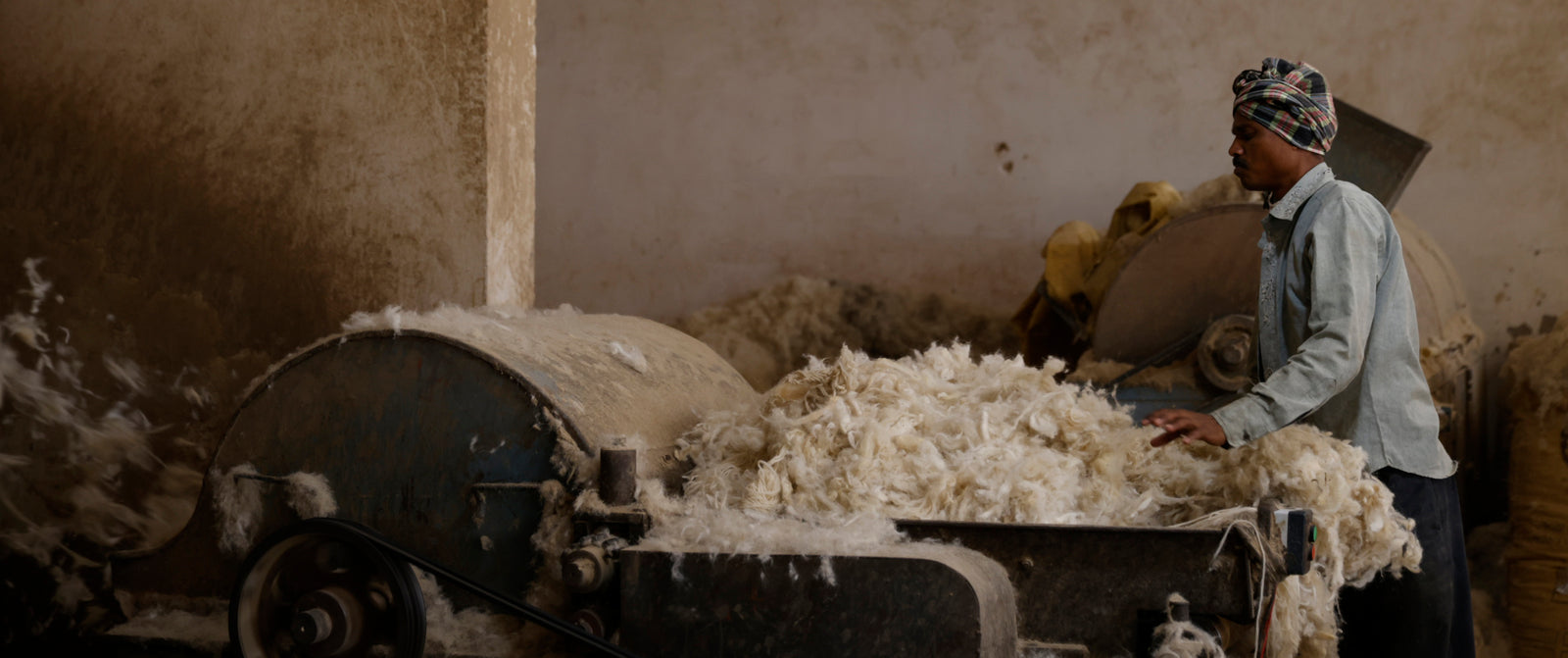
Glossary
OF MATERIALS, CONSTRUCTIONS & PROCESSES
The term "Abrash" refers to the weathered appearance of a rug, characterized by variations in color. These variations can arise from various factors, including irregularities in yarn consistency, differences in knot thickness, variations in dye absorption by the yarn, or the specific type of wool used.
Cotton, a soft and fluffy staple fiber, grows within protective capsules called bolls surrounding the seeds of cotton plants.
Dyeing involves immersing yarn into dye vats to saturate them with colors. Plant fibers like cotton and jute are dyed with fiber reactive dyes, while protein fibers like wool and silk are dyed with acid dyes. Synthetic fibers are solution dyed before the yarn extrusion process.
Flatweaves are woven on a loom and are without pile or knots. Examples include kilims, pit looms, and dhurries.
Hand-spun yarns are spun manually using a tool called a charkha. They exhibit irregularities in thickness and consistency, lending them a rustic, handmade effect.
Carding is the process of aligning raw, wavy fibers in preparation for spinning. When hand-carded, raw fibers are brushed between two bristled pads. The process lends itself to a textural, one of a kind end product.
Hand-knotted rugs are individual works of art that take months to complete. They are knotted on upright looms that are warped with taut foundation yarn. Artisans meticulously tie individual knots on each warp thread, progressing line by line. Upon completing a line, the knots are secured in position with a weft thread before proceeding to the next line of knotting. Larger projects are often a collaborative effort, involving multiple weavers working as a community to actualize the final piece.
In crafting hand-tufted rugs, artisans use a tufting gun to punch looped or cut yarn through a rigid cotton backing. Typically, the design outline is sketched on to the backing and is used as a guide for the artisan to bring the rug's final pattern to life.
Handwoven rugs come to life through the rhythmic movement of a shuttle--a wooden and metal hand tool that holds a bobbin wound with yarn. A shuttle is skillfully maneuvered by the weaver across the loom in an east-west motion, perpendicular to the warp yarns. The warp yarns are pulled taut on either a floor loom or upright loom, and are the structural foundation of any hand-woven rug. Row by row, the weft yarns are woven over and under the warp, gradually building a design.
Hemp is a fiber sourced from the stalks of the Cannabis plant. It is strong, regenerative, and has a beautiful irregular natural texture.
Jute is a lengthy, textural, lustrous bast fiber harvested from the namesake plant. It is a low maintenance regenerative crop that takes only about 4 months to harvest. Jute rugs are natural, timeless, and rustic.
Linen fibers are harvested from the bast of the flax plant. They are long, strong, luxurious, and quite lustrous. Linen rugs have a high-end yet natural feel, and feel wonderful underfoot.
New Zealand wool fibers are long, exceptionally soft, and are inherently resilient enough to bounce back after being walked on time after time.
Recycled PET is a soft and eco-friendly fiber resembling wool in texture and appearance. PET offers exceptional durability and effortless cleaning, and is inherently mildew resistant. Crafted through the sorting, washing, and melting of recycled plastic that would otherwise occupy landfills, one rug is comprised of hundreds of repurposed plastic bottles.
Machine-made rugs are crafted through automated processes on electrically powered looms controlled by computer systems. This advanced technology allows for an extensive array of color choices, high-density pile, intricate designs, and diverse fiber options, with a notably shorter production time compared to handmade methods. Primarily composed of man-made and synthetic fibers such as viscose, polyester, polypropylene, or recycled PET yarns, these rugs offer convenient maintenance due to their inherent easy care and stain-resistant properties.
Silk stands unparalleled in its otherworldly soft hand and lustrous sheen. It is incredibly strong and has been known to outlast wool in durability. For a more natural feel we use hand-spun silk from hatched cocoons that gives a more raw, uneven finish.
Sisal is derived from the leaves of the Agave sisalana cactus plant. Sisal has a distinctively coarse texture and is stronger and more durable than other natural fibers.
Tencel is a biodegradable fiber crafted from responsibly sourced wood pulp. Its extra soft texture mirrors silk. It was designed to be more resilient than its sister fiber viscose.
Viscose is a biodegradable fiber crafted from responsibly sourced wood pulp. Its sumptuous velvety texture mirrors silk.
The warp serves as the vertical foundation of a rug. It is comprised of tensioned warp threads arranged vertically on the loom. The weft is woven horizontally through the warp.
The weft yarns are woven horizontally over and under the warp yarns. They typically bring color and texture to the final piece, concealing the warp.
Valued for its softness, warmth, and inherent strength, sheep's wool has been a versatile natural material for thousands of years. It is naturally resistant to water and flame, and has a crimp that makes it incredibly resilient underfoot.
